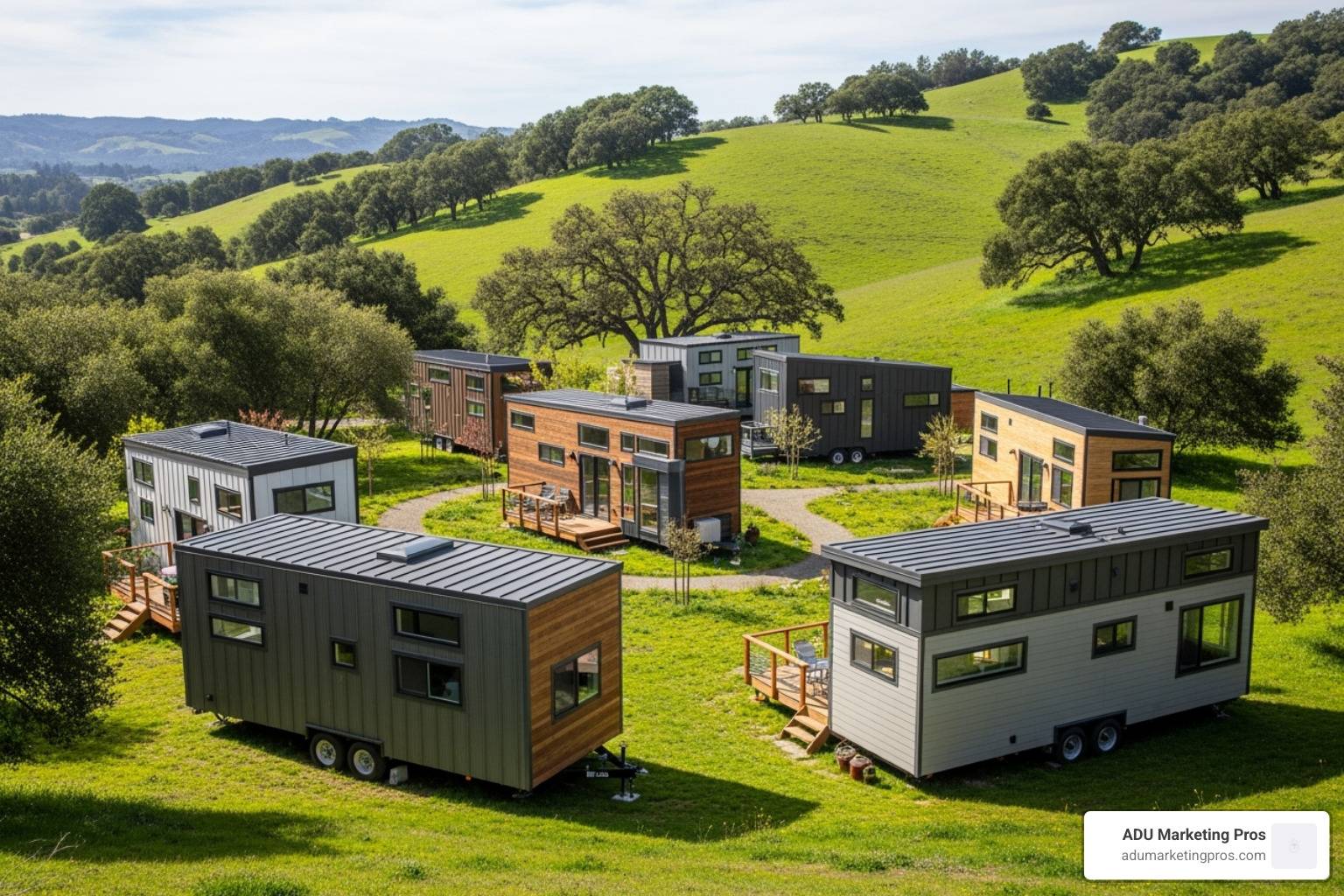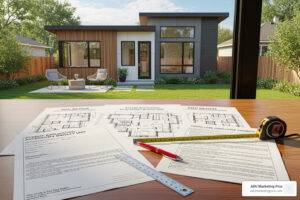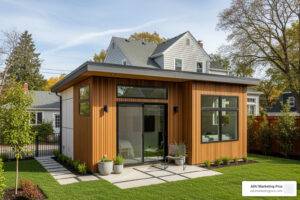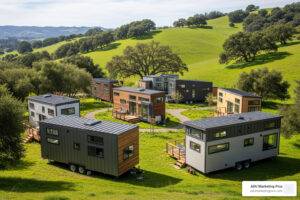Why Tiny Home Rentals Are Changing Bay Area Living
Tiny homes for rent bay area are emerging as a powerful and practical solution to one of the nation’s most challenging housing markets. In a region where the median rent for a traditional one-bedroom apartment consistently soars past $3,000, these compact, thoughtfully designed dwellings offer a unique blend of affordability, character, and lifestyle freedom. With monthly rents spanning a more accessible range of $700 to $2,400, tiny homes provide significant financial relief without demanding a move to the far-flung suburbs.
This shift isn’t just about saving money; it’s about redefining what it means to live well in the Bay Area. The movement attracts a diverse crowd, from tech professionals in Silicon Valley seeking a minimalist antidote to a high-stress career, to artists and nature lovers in Marin wanting to live closer to their inspiration. They are choosing to trade sprawling, underutilized space for efficient, high-quality living environments that prioritize experience over possessions.
Quick Answer: Where to Find Bay Area Tiny Home Rentals
- Airbnb & VRBO: Best for short-term stays and testing the lifestyle. Over 20 long-term options are often available, with an average guest rating of 4.8/5 stars.
- Craigslist & Facebook Marketplace: Top resources for long-term monthly rentals, including ADUs and land leases, with prices from $795-$2,375.
- Specialized Communities: Places like Park Delta Bay offer legal, year-round living for Tiny Homes on Wheels (THOWs).
- Price Range: Expect $700-$2,500/month, heavily dependent on location, size, and included amenities.
- Popular Locations: High concentrations are found in Oakland, Berkeley, San Jose, Mill Valley, Richmond, and Santa Cruz.
The Bay Area’s housing crisis, fueled by a booming tech economy and limited housing stock, has become a catalyst for innovation. Tiny homes represent one of the most compelling solutions, offering affordability without sacrificing location. These aren’t the cramped, uninspired boxes one might imagine. Many feature full-size kitchens with modern appliances, reliable high-speed WiFi, luxurious bathrooms, private patios, and even coveted extras like hot tubs or access to hiking trails. While a standard San Francisco apartment lease can feel like a financial straitjacket, a tiny home rental—or even a land lease for your own THOW starting as low as $495—provides a financially viable and deeply personal alternative to the status quo.
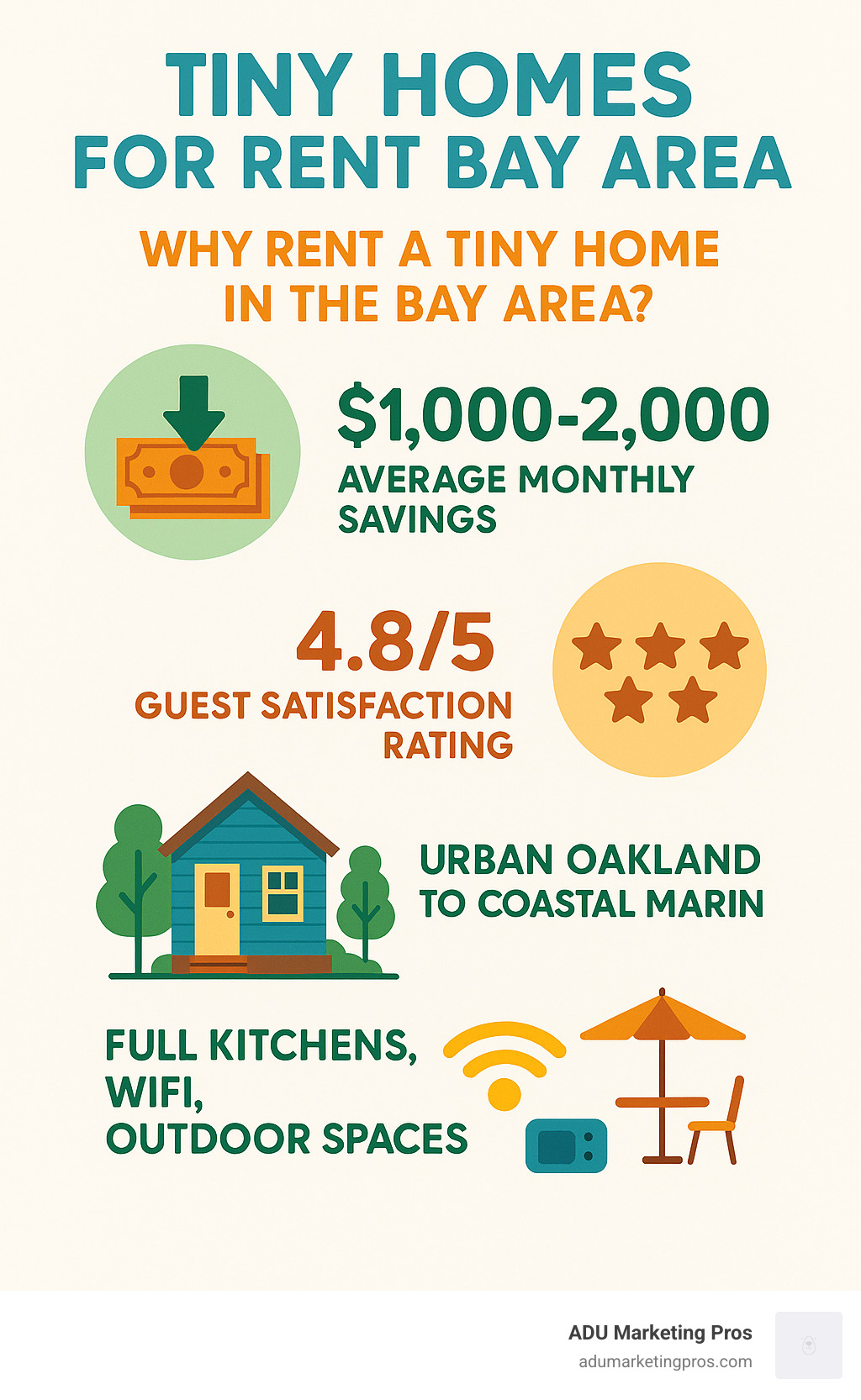
Why Rent a Tiny Home in the Bay Area?
Living in the Bay Area often feels like an impossible balancing act between world-class career opportunities, cultural richness, and the crushing weight of housing costs. Tiny homes for rent Bay Area offer a refreshing and increasingly popular solution, fundamentally changing how residents approach their homes, finances, and overall lifestyle.
The most significant and immediate draw is the dramatic cost savings. In cities like San Francisco or San Jose, where a typical studio apartment can easily command $2,800-$3,500 per month before utilities, the financial pressure is immense. In contrast, you could find yourself in a charming, well-appointed tiny home for as little as $795 per month. Even high-end, feature-rich tiny rentals in desirable locations rarely exceed $2,400. This financial freedom is transformative; it allows you to truly enjoy the Bay Area’s offerings—from its culinary scene to its outdoor adventures—not just survive within it. The savings extend beyond rent; reduced utility bills for heating and cooling a smaller space, along with minimal maintenance, contribute to a healthier bank account and more free time on your weekends.
Beyond the finances, renting a tiny home encourages a minimalist and intentional lifestyle. The physical constraints of a smaller footprint (typically 150-500 square feet) prompt a conscious evaluation of your possessions. This process of downsizing forces you to prioritize quality over quantity, keeping only the items that are truly useful or bring you joy. For many, this is a liberating experience that reduces clutter not just in the home, but also in the mind. While this can be a challenge for those with extensive collections or space-intensive hobbies, the unique, creative designs of modern tiny homes—featuring multi-purpose furniture, hidden storage, and vertical space—help maximize every square foot.
Tiny homes also provide access to unique locations and unparalleled access to nature. You simply won’t find a traditional apartment complex tucked into a serene redwood grove in Mill Valley or perched on a coastal bluff overlooking the Pacific in Half Moon Bay. Many tiny home rentals are situated in backyards, on rural properties, or in communities that offer a closer connection to the outdoors, right at your doorstep.
Eco-friendly living is another inherent benefit. The environmental impact of a tiny home is a fraction of a traditional house or apartment. Heating and cooling a 400-square-foot space is far more efficient than a 1,200-square-foot apartment, leading to substantially lower utility bills and a smaller carbon footprint. Many are built with sustainable materials and can incorporate features like solar panels and rainwater collection systems.
Finally, the flexibility of renting is perfect for those in a life transition. It allows you to test-drive different neighborhoods—from the urban energy of Oakland to the coastal calm of Santa Cruz—or the minimalist lifestyle itself without the commitment of a long-term lease or mortgage. However, it’s important to be aware of potential zoning complexities, especially for Tiny Homes on Wheels (THOWs), which are often classified as RVs. Additionally, some units may lack traditional amenities like a full-sized bathtub or an in-unit washer/dryer, requiring small lifestyle adjustments. For those curious about the structural differences, there’s an important distinction between ADU vs. Tiny House setups that affects both legal considerations and rental options.
| Location | Traditional 1-Bedroom Rent | Tiny Home Rental Range | Monthly Savings |
|---|---|---|---|
| San Francisco | $3,000-$3,500+ | $1,500-$2,400 | $600-$2,000+ |
| Oakland | $2,500-$3,000+ | $1,100-$2,375 | $125-$1,900+ |
| San Jose | $2,400-$2,800+ | $1,750-$2,000 | $400-$1,050+ |
A More Affordable and Unique Lifestyle
Ultimately, choosing a tiny home for rent in the Bay Area is a conscious decision to prioritize experiences over square footage. The substantial savings can be redirected to fund travel, pay off debt, invest, or simply reduce financial anxiety. This lifestyle shift frees up not just money, but also time and mental energy, transforming the Bay Area from a place of financial burden into an exciting and enjoyable place to build a life.
A Guide to Tiny Homes for Rent Bay Area
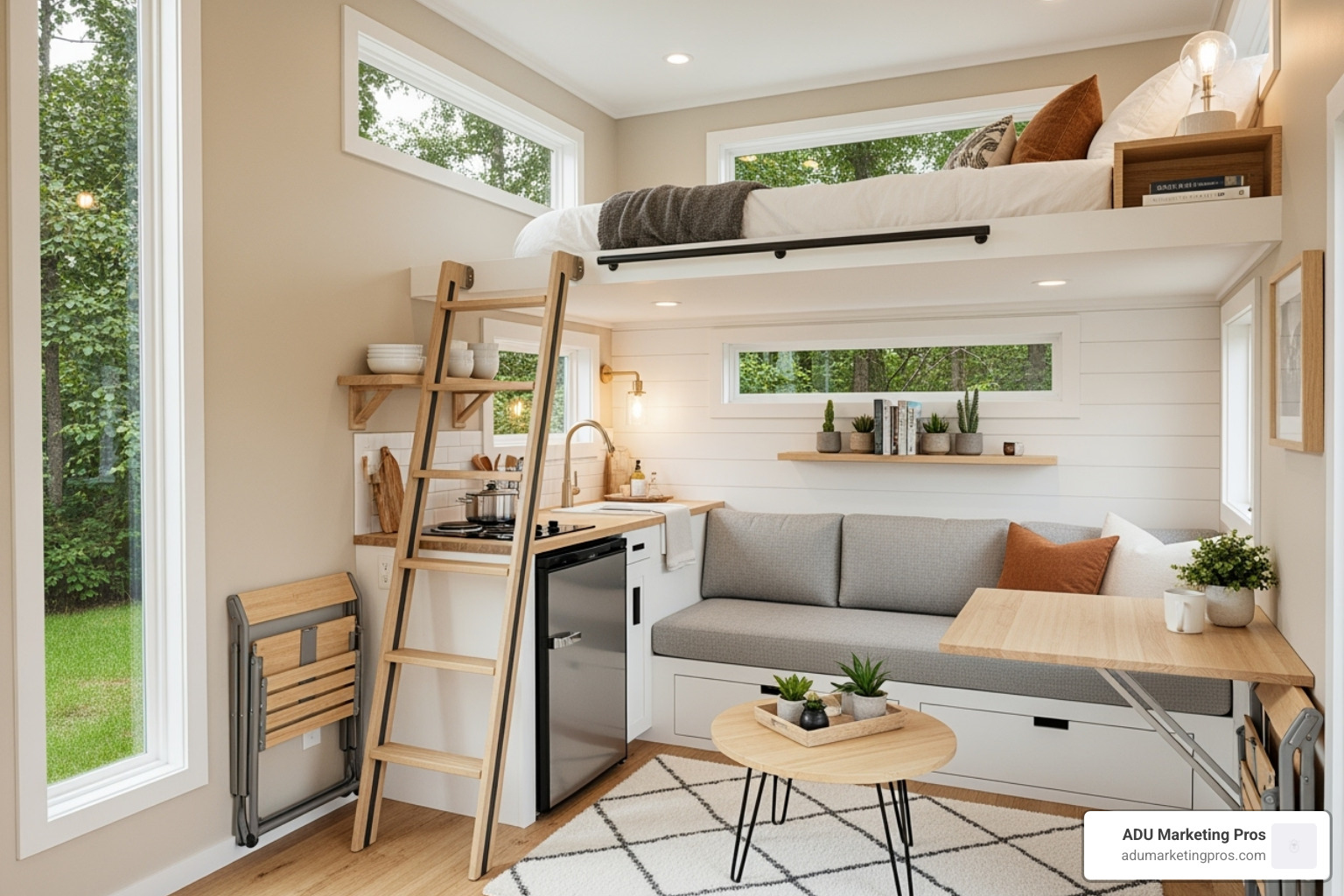
From sleek, modern backyard ADUs in bustling city centers to secluded, rustic cabins on wheels nestled in the forest, the Bay Area’s tiny home rental market is remarkably diverse. It offers something for nearly every lifestyle, budget, and aesthetic preference. Most rentals fall into two main categories: Accessory Dwelling Units (ADUs), which are built on permanent foundations in the backyards of existing properties, or standalone structures, which can range from portable THOWs to small, permanent cabins. Let’s explore what each region has to offer.
Urban Retreats in Oakland & Berkeley
The East Bay cities of Oakland and Berkeley have become hotspots for urban tiny living, offering a vibrant city experience without the astronomical costs of San Francisco. The rentals here are predominantly stylish ADUs and converted backyard cottages, providing private, self-contained sanctuaries within established, walkable neighborhoods like Rockridge, Temescal, or North Berkeley. Key benefits include unbeatable proximity to city life and easy BART access for commuting to San Francisco or other parts of the Bay. Most of these urban rentals feature full kitchens and reliable high-speed WiFi, making them ideal for remote workers seeking a dedicated live/work space. The high walkability of these areas puts trendy restaurants, independent coffee shops, farmers’ markets, and cultural venues just a short stroll away. For those inspired by these efficient urban dwellings, experienced San Francisco Tiny House Builders are adept at maximizing style and function in these compact footprints.
Silicon Valley Compact Living in San Jose & Palo Alto
In the heart of the tech world, San Jose, Palo Alto, and surrounding cities like Mountain View and Sunnyvale, tiny homes cater to a demographic of tech professionals and entrepreneurs seeking a simplified, efficient lifestyle close to major campuses like Apple, Google, and Stanford University. These rentals emphasize modern amenities, efficient layouts, and smart home features such as app-controlled lighting, smart locks, and high-tech security. Locations are often strategic, like this Standalone Tiny House in Palo Alto, offering a peaceful, private retreat with a minimal commute. The focus here is on innovative, low-maintenance living for a workforce that often values flexibility, experiences, and financial savvy over large mortgages and extensive property upkeep.
Coastal Charm & Redwood Escapes in Marin and the Peninsula
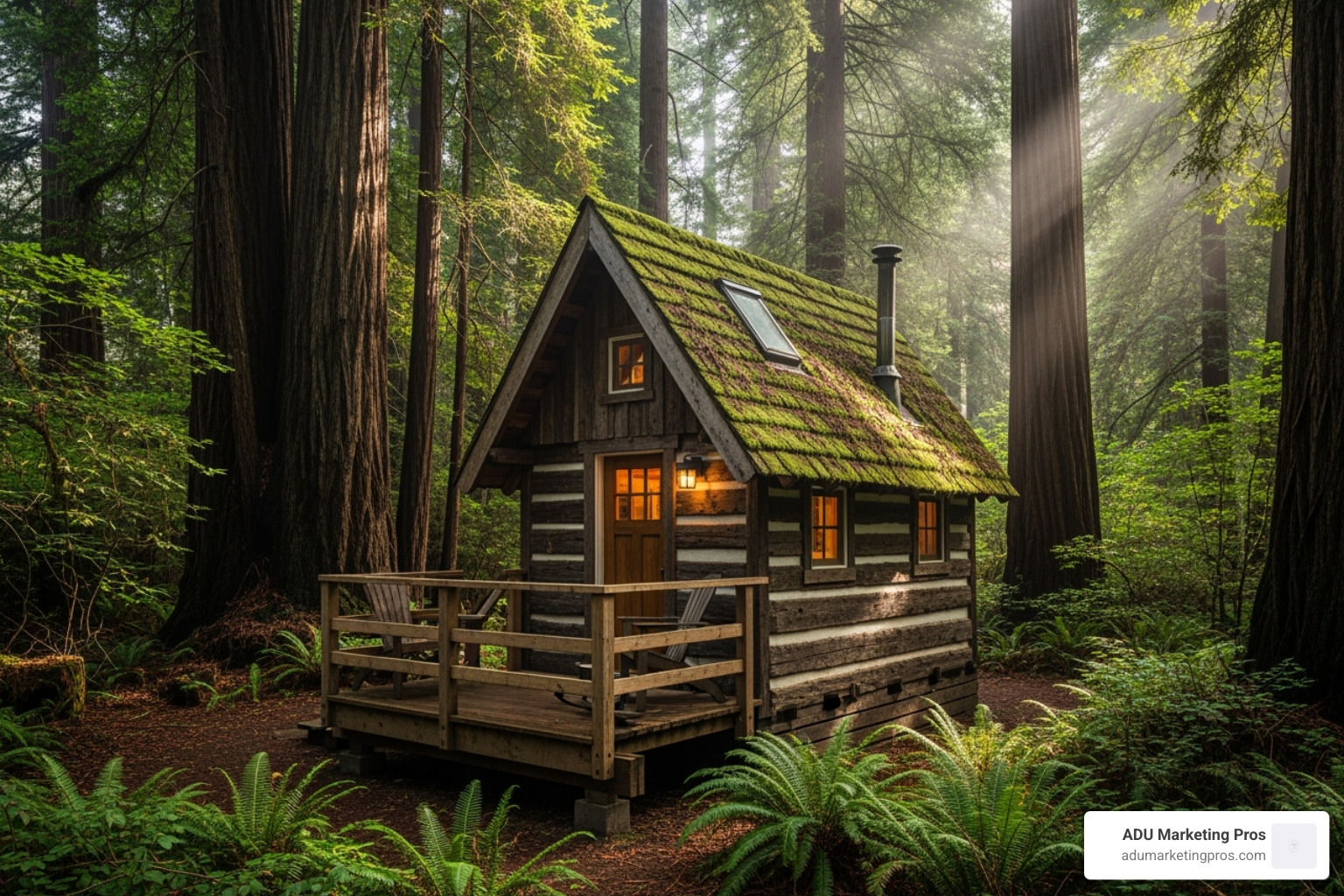
For those who crave direct nature access and tranquility, Marin County and the coastal Peninsula offer tiny home experiences that feel worlds away from the urban hustle. Imagine sipping your morning coffee with sweeping coastal views in Pacifica or spending your evenings surrounded by towering redwoods in Mill Valley. These peaceful retreats often feature amenities that extend your living space into the outdoors, such as private decks, hot tubs, outdoor showers, and fire pits. With proximity to iconic natural landmarks like Muir Woods National Monument and Mt. Tamalpais State Park, world-class hiking, mountain biking, and trail running are literally at your doorstep. A strong sense of community is also a major draw, with some tiny homes forming intentional communities focused on sustainability and shared values, as explored in articles like What’s It Like to Live in Northern California’s First Tiny-Home Community?. These rentals are perfect for anyone seeking a slower, more nature-connected lifestyle without leaving the Bay Area’s orbit.
North Bay Wine Country & Artistic Enclaves
Stretching north into Sonoma and Napa counties, the concept of tiny living takes on a distinctively pastoral and artistic flavor. Here, you’ll find rentals on sprawling vineyards, farms, and ranches, offering a lifestyle connected to the agricultural rhythms of wine country. These homes often feature rustic-chic designs with large windows to take in views of rolling hills and vineyards. It’s an ideal setting for remote workers, writers, or anyone seeking creative inspiration and a quieter pace of life. Cities like Santa Rosa and Petaluma offer a great blend of this rural feel with charming downtowns, excellent food scenes, and a strong sense of local community. Renting a tiny home here provides a unique opportunity to immerse yourself in one of the world’s most famous food and wine destinations.
What to Expect: Prices, Amenities, and the Rental Process
Once you’ve decided that a tiny home for rent Bay Area is the right move for you, the next step is to dive into the practical details. Understanding the nuances of cost, what features to expect, and how the rental process works will empower you to find the perfect small space. With an average guest rating of 4.8 out of 5 stars across various platforms, Bay Area tiny rentals are highly regarded, but it pays to do your homework.
Average Rental Prices for tiny homes for rent bay area
The cost to rent a tiny home in the Bay Area is far more varied than the standardized pricing of large apartment complexes. This diversity offers options for many budgets, but it also means you need to understand the factors that influence price.
Location, size, and quality of amenities are the primary drivers. A brand-new, high-end ADU in Palo Alto with luxury finishes will command a much higher rent than a rustic, off-grid cabin in a more remote part of the East Bay. The price range typically falls between $700 to over $2,500 per month.
- $700 – $1,200: At this lower end, you might find a basic land lease for your own THOW (starting around $495-$800), a very small and simple room-for-rent style unit, or a more rustic cabin in a less central location.
- $1,200 – $1,900: This is the sweet spot for many renters, offering well-designed ADUs or THOWs in good locations like Oakland or the East Bay suburbs. Expect a functional kitchenette, a clean design, and dedicated parking.
- $1,900 – $2,500+: At the high end, you’ll find premium, spacious tiny homes in prime locations like Marin or Silicon Valley. These often feature full-size appliances, luxury finishes (like stone countertops), in-unit laundry, and desirable extras like a hot tub or private garden.
Also, consider the difference between monthly vs. nightly rates. While platforms like Airbnb are great for searching, their nightly rates, cleaning fees, and taxes can add up quickly for extended stays. Whenever possible, negotiating a monthly rate directly with an owner for a long-term stay is more cost-effective. Always clarify if utilities (water, electricity, gas, trash, internet) are included in the rent, as some communities or landlords bill them separately, which can add $100-$250 to your monthly cost. For more on the costs of building compact spaces, see our analysis of Bay Area ADU Cost.
Key Features and Pet-Friendly Options
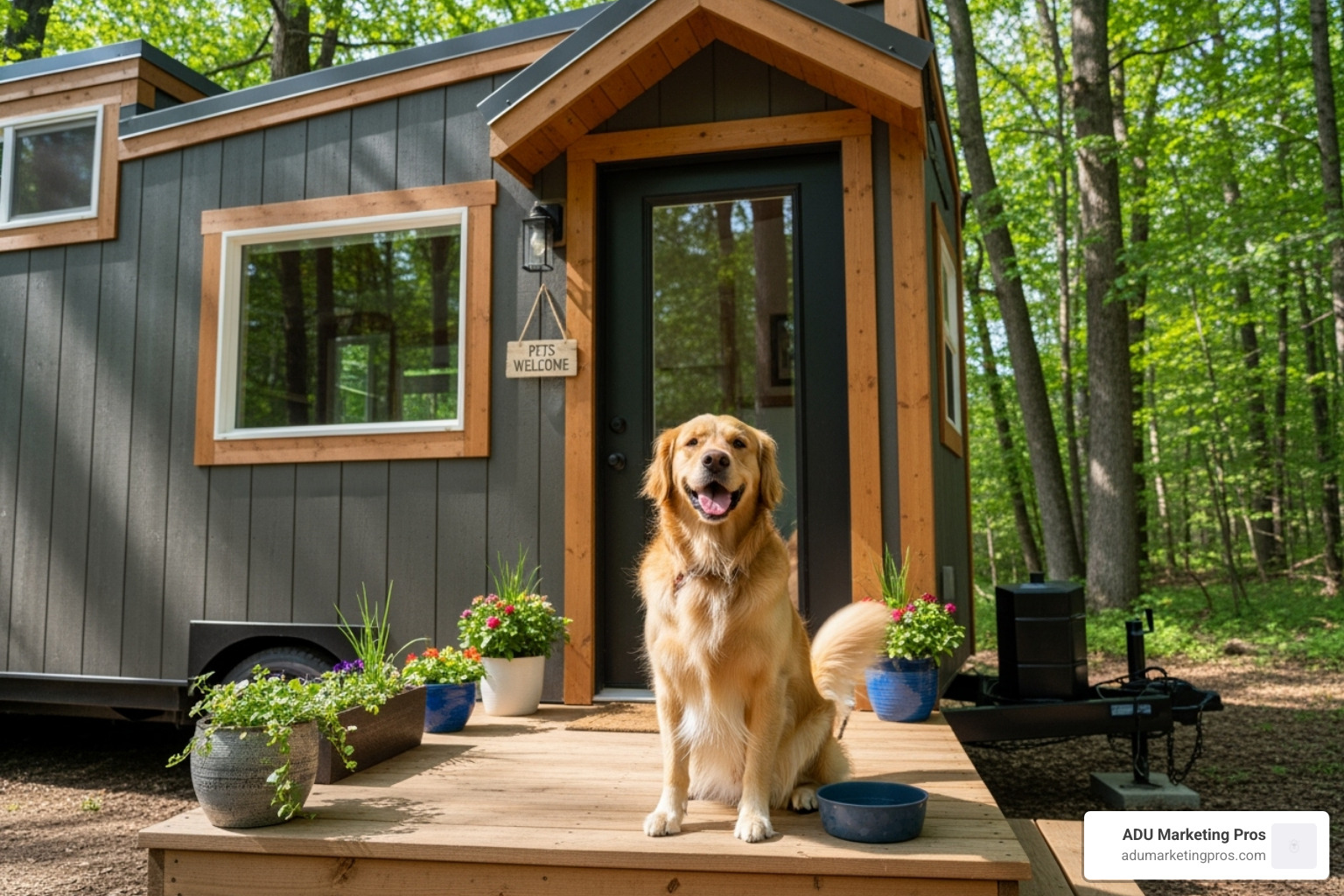
When hunting for your perfect tiny home, you’ll find that these compact spaces often punch well above their weight in terms of smart features and amenities.
- Essential Amenities: Nearly all rentals will include a functional kitchen, though this can range from a simple kitchenette with a hot plate and mini-fridge to a full setup with an oven and dishwasher. Reliable WiFi and a dedicated free parking spot are also standard in most listings. Laundry access varies widely; some premium units have in-unit washer/dryer combos, while others offer shared facilities on the property or are located conveniently near a laundromat.
- Desirable Extras: The best tiny homes maximize their connection to the outdoors. Look for private patios, decks, or outdoor seating areas to expand your living space and enjoy the Bay Area’s favorable climate. Higher-end rentals may feature sought-after luxuries like hot tubs, saunas, or fire pits. Given the temperature swings, ensure the unit has an efficient heating and AC system for year-round comfort.
- Pet-Friendly Options: The Bay Area is a pet-loving region, and many tiny home rentals welcome furry friends. Use the ‘pet-friendly’ filter on rental platforms to find places with desirable features like fenced yards or easy access to trails. Expect to pay a one-time pet deposit or a small monthly pet fee. Always communicate openly with the owner about your pet’s breed, size, and temperament beforehand to ensure a smooth and welcoming process for everyone.
The Rental Process: From Search to Move-In
The rental process for a tiny home combines traditional apartment-hunting steps with a few unique considerations.
- Where to Search: Use Airbnb and VRBO for short-term stays or to “try before you buy” the lifestyle for a month or two. For long-term rentals (6+ months), Craigslist is a surprisingly strong resource for direct-from-owner listings of tiny homes, ADUs, and land leases. Zillow and Facebook Marketplace are also increasingly popular. Don’t forget to check the websites of specialized tiny house communities directly.
- Application & Vetting: The application process mirrors traditional rentals. Be prepared for background and credit checks (with a typical, non-refundable fee of around $40 per applicant). You will need to provide proof of income (usually 2-3 times the monthly rent) and have personal or professional references ready. Writing a brief, friendly cover letter explaining why you’re interested in their specific tiny home can help your application stand for out.
- Leases and Deposits: Short-term rentals are handled through the booking platform’s system. For long-term rentals, you will sign a formal lease agreement outlining all rules, responsibilities, and the rental term. A security deposit, typically equal to one to two months’ rent, is standard practice. Before signing, do a thorough walk-through and document the condition of the property. For those with their own tiny home, resources like the American Tiny House Association offer valuable guidance on parking and community regulations.
Legal & Practical Considerations for Bay Area Tiny Living
Before you pack your bags and sign a lease, it’s crucial to understand the legal and practical landscape of tiny home rentals in the Bay Area. The rules can be complex and vary significantly depending on whether the home is on a permanent foundation or on wheels, as well as by city and county. A little due diligence upfront can save you from major headaches down the road.
Navigating Zoning Laws and Regulations
The legality of your tiny home rental hinges on its classification. Understanding this distinction is the most important step in ensuring your living situation is stable and secure.
- Accessory Dwelling Units (ADUs): This is the most straightforward and legally secure path for tiny living in the Bay Area. ADUs are built on permanent foundations, often in the backyards of single-family homes. Thanks to recent state laws designed to combat the housing shortage, most Bay Area cities—including San Jose, Oakland, Berkeley, and Alameda—have streamlined processes for permitting ADUs. When you rent an ADU, you are renting a fully legal, code-compliant dwelling unit, which provides the same tenant rights and stability as a traditional apartment.
- Tiny Homes on Wheels (THOWs): This is where things get more complicated. In the eyes of the law, most THOWs are classified as Recreational Vehicles (RVs). As such, living in one full-time is generally restricted to designated RV parks or specially zoned tiny home communities. For example, the popular Park Delta Bay community requires that all THOWs be RVIA certified, which is a third-party certification ensuring the home meets safety standards for electrical, plumbing, and structural systems. Attempting to rent a THOW parked in a friend’s backyard or on a vacant lot is often illegal and can lead to eviction if discovered by code enforcement. Before signing a lease for a THOW, always verify that its location is properly zoned for full-time occupancy. Our guide to Places in Southern California That Allow Tiny Houses highlights similar challenges and solutions.
Key Practical Considerations for Daily Life
Beyond the legal framework, tiny living comes with a unique set of practicalities to consider.
- Insurance: Your landlord’s policy covers the structure, but not your belongings. Getting renter’s insurance is highly recommended. It’s typically inexpensive and can cover your possessions in case of theft, fire, or damage. Be sure to specify that you are living in an ADU or, if applicable, a certified THOW, to ensure you get the correct coverage.
- Mail and Deliveries: For ADUs with a legal address, this is straightforward. For THOWs in communities, there’s usually a central mailbox system. If you’re in a more informal or rural setting, you may need to get a P.O. Box for mail, though package delivery services like Amazon, UPS, and FedEx can usually find you with good directions or a designated drop-off spot.
- Utilities and Connectivity: In an ADU, utilities are often tied to the main house and may be included in the rent or billed separately. For THOWs, you’ll be dealing with RV-style hookups for water, sewer, and electricity. Ask about the power source (30-amp vs. 50-amp) and whether the sewer is a direct hookup or requires a holding tank. Critically, test the cell signal and internet speed before you commit. While many urban ADUs have excellent fiber internet, some rural spots may have spotty service, requiring a signal booster or a dedicated satellite internet plan.
Finding Your Perfect tiny homes for rent bay area on the Right Platform
Using the right platform will streamline your search and connect you with the right type of rental for your needs.
- Short-Term & “Try Before You Buy”: Airbnb and VRBO are ideal for vacation rentals or for testing the tiny lifestyle for a few weeks or months. They offer detailed listings, high-quality photos, and verified guest reviews for a low-commitment experience.
- Long-Term Rentals: Craigslist remains a surprisingly robust source for direct-from-owner listings, including ADUs, backyard cottages, and land leases. Use creative search terms like “ADU for rent,” “in-law unit,” “casita,” or “backyard cottage.” Facebook Marketplace and Zillow are also excellent resources with growing inventory.
- Community Living: For a lifestyle-focused option, go directly to the source. Check the websites of established communities like the Delta Bay Tiny House Village. They have their own application processes for long-term residents and offer a built-in sense of community that many renters seek. For those considering the leap from renting to owning, the American Tiny House Association is an excellent resource for navigating the broader tiny home movement.
Frequently Asked Questions about Renting Tiny Homes
When you’re considering tiny homes for rent bay area, a lot of questions naturally come to mind. It’s a unique lifestyle with its own set of rules and realities. Here are detailed answers to some of the most common inquiries.
How much does it cost to rent a tiny home in the Bay Area?
Rental costs vary widely based on location, size, age, and amenities, typically ranging from $700 to $2,500+ per month. At the lowest end ($700-$1,200), you’ll find land lease spots for your own THOW or very basic, small units in less central locations. The mid-range ($1,200-$1,900) covers most well-appointed ADUs and tiny homes in the East Bay and suburbs. The high end ($1,900+) is for premium rentals in prime locations like Marin or Silicon Valley, often with luxury features. This almost always represents a significant saving compared to traditional apartments in the same neighborhood. Remember to clarify if utilities are included, as this can add $100-$250 to your monthly costs.
Is it legal to live in a tiny home full-time in the Bay Area?
Yes, but the legality depends entirely on the type of home. Tiny homes on a permanent foundation (ADUs) are legal for full-time living in most Bay Area cities like San Jose, Oakland, and Berkeley, as they are built to local and state building codes. This is the most secure and legally protected way to rent a tiny home. Tiny Homes on Wheels (THOWs) are usually classified as RVs. Full-time residency in a THOW is typically only legal in designated RV parks or specialized tiny home communities like Park Delta Bay, which requires RVIA safety certification. Renting a THOW parked in a residential backyard is a legal gray area at best and is prohibited in many cities.
Where can I find long-term tiny home rentals?
For long-term rentals (6-12 months or longer), your best bets are online marketplaces. Craigslist is a top source for direct-from-owner listings. Use a variety of search terms like “ADU for rent,” “in-law unit,” “casita,” and “backyard cottage” to broaden your results. Zillow and Facebook Marketplace are also excellent and have user-friendly map search features. For a community-oriented experience, check the websites of specialized tiny house communities directly. For short-term or trial stays, Airbnb and VRBO are the go-to platforms.
What are the biggest challenges of tiny home living?
The biggest challenges are often related to space and lifestyle adjustments. Storage is the most obvious one; you must be ruthless about clutter and clever with organization. Hosting guests can be difficult, often requiring convertible furniture and utilizing outdoor space. For some, especially in more isolated rural rentals, there can be a feeling of isolation compared to a bustling apartment building. Finally, there’s a learning curve for some of the unique systems, like composting toilets or RV-style utility hookups, that may be part of the experience.
Can I rent a tiny home with a partner or family?
Absolutely, but it requires excellent communication, organization, and a shared commitment to the minimalist lifestyle. Many couples find that a well-designed tiny home (in the 300-500 sq. ft. range) is perfectly comfortable. Some larger tiny homes are even designed for small families, featuring separate sleeping lofts or bunk areas for children. The key is finding a layout that provides small zones for privacy and ensuring everyone is on board with living in close quarters.
How is internet and cell service in tiny home rentals?
This varies dramatically by location. An urban ADU in Berkeley will likely have access to the same high-speed fiber internet as the main house. A rural tiny home in the Santa Cruz mountains might have spotty cell service and rely on satellite internet, which can be slower. This is a critical question to ask the landlord, and if you work from home, it’s essential to test the signal and run an internet speed test during your tour of the property before you sign a lease.
Conclusion
Renting a tiny home for rent Bay Area offers more than just an affordable alternative in a notoriously expensive region; it presents a chance to live more intentionally, trading excessive rent and clutter for financial freedom and unique daily experiences. Whether you’re drawn to the creative energy of an urban ADU in Oakland, the innovative efficiency of a Silicon Valley studio, or the profound tranquility of a redwood cabin in Marin, there is a small space that can fit your vision and your budget, often for hundreds or even thousands less than a traditional apartment.
This lifestyle is a conscious choice to prioritize experiences over possessions. The money saved on rent and the time saved on maintenance can be redirected toward travel, hobbies, dining out, or accelerating financial goals like saving for a down payment or paying off debt. For those curious about minimalism but not ready to commit to ownership, renting provides the perfect, low-risk opportunity to test the waters and see if the lifestyle fits.
The growing demand for these flexible living solutions is clear. As more people seek authentic, sustainable, and affordable housing, the market for tiny homes and ADUs will continue to expand. At ADU Marketing Pros, we specialize in bridging the gap, connecting forward-thinking construction firms with homeowners and aspiring tiny-dwellers who are ready to build.
The Bay Area’s tiny home rental market is not merely a housing trend; it’s a meaningful movement toward a more sustainable, financially sound, and fulfilling way of life. By choosing this path, you’re not just finding a place to live—you’re joining a vibrant community that understands the immense value of living well, with less.
Ready to take the next step from renting to building your own? Find top ADU builders in the Bay Area and start the journey toward creating your own small-scale dream home today.

